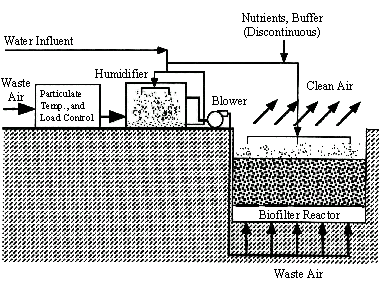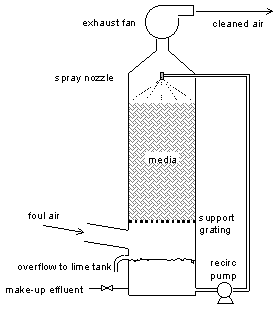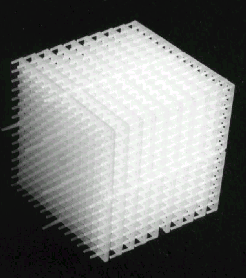Chemical and Process Engineering Resources
Trickling Biofilters for Hydrogen Sulfide Odor Control
Dec 13 2010 01:36 PM | mwu in Separation TechnologyControlling hydrogen sulfide and other odor emissions is a major issue for most wastewater treatment plants. H2S odors can by reduced to very low levels by wet scrubbers using caustic and chlorine or sodium hypochlorite. However, the chemical storage, metering, and control equipment all add to the cost of a scrubber. The chemicals are hazardous, and the amounts required to treat H2S are quite high, so the cost of operating the scrubber can quickly add up.
Introduction
One way to cut the cost of chemicals is to utilize microorganisms to break down most of the hydrogen sulfide using oxygen from the air.
Using microorganisms to remove odor or volatile organic compounds from air streams is not a new idea. Biofiltration has been used, especially outside the United States, for many years.1,2 For H2S odor control, the key is to provide an ideal habitat for the growth of sulfide-oxidizing bacteria, to the exclusion of competing microbes which normally predominate in aerobic treatment processes.
Several species of microorganisms can oxidize hydrogen sulfide to form odorless sulfuric acid. A few species of the genus Thiobacillus are capable of oxidizing H2S at low pH. Thiobacillus thiooxidans, in particular, thrives at pH <3, and its growth is not inhibited until the pH falls below 1.3
 |
| Figure 1: Conventional Biofilters6 |
Efficient removal of H2S requires media with enough surface area to maintain a large population of sulfide-oxidizing microbes.
Porous media such as soil, peat, compost and/or wood chips work well in biofilters for removal of organic vapors, although they require careful control of temperature and humidity. If the air is not fully saturated with water vapor, some of the medium may dry out, inactivating the microbes on it. On the other hand, excessive moisture can cause water to accumulate in the media, and eventually wash away nutrients.
The weight of moist media limits the depth that can be used without excessive compression. Worst of all, sulfuric acid formed by biological oxidation of sulfur compounds can degrade such media, causing them to collapse.
As a result, conventional biofilters using these media often need a caustic scrubber as a pretreatment stage to humidify the inlet air stream and remove sulfur compounds.
To eliminate the need for pretreatment of the air or for periodic replacement of degraded media, biofilters can be built using acid-resistant inorganic substrates such as porous lava rock. These are referred to as "trickling biofilters" (or "biotrickling filters") because the media is kept wet-regardless of the humidity-by continuous circulation of water.
 |
| Figure 2: Trickling Biofilter |
However, the weight of rock media makes it difficult to handle, and limits the depth of a filter bed that can be installed without expensive reinforced structures. The fan power needed to force air through a bed of lava rock is also quite high. As a result, trickling biofilters using rock media must be sized for very low gas velocities, resulting in huge footprints.
Nitrifying trickling filters using plastic media have also been used for H2S odor control,4 but the limited surface area of conventional trickling-filter media results in relatively low bacterial populations per unit volume. Air residence times on the order of minutes are required for efficient odor removal. The cost of such enormous filters cannot be justified unless they are needed to nitrify wastewater.
In order to overcome the drawbacks of conventional media, Lantec Products has developed a high-density polypropylene media known as HD Q-PAC.
This media is acid-resistant, lightweight, easy to handle, and rigid enough to walk on. It can be stacked to any desired depth. It provides 132 ft2 of plastic surface per cubic foot, yet it has a high void fraction, so that even when coated with a layer of biofilm it still presents much less resistance to air flow than compost or rock media.
This makes it possible to treat air at higher superficial velocities with reasonable fan power requirements, so trickling biofilters can be made taller rather than wider, saving valuable space in crowded treatment facilities.
 | Material: | Polypropylene |
| Specific Surface Area: | 132 ft2 / ft3 | |
| Drip Points: | 75,000 / ft3 | |
| Bulk Density; | 7.5 lb / ft3 | |
| Void Fraction: | 87.8 % | |
| Smallest Grid Opening: | 0.16" 0.16" | |
| Standard Module Size: | 12" x 12" x 12" | |
| Figure 3: HD Q-PAC® |

 FB
FB

0 Comments